Do you have a big golf tournament coming up?
Or, are you just simply pressed for time and can’t take another round of getting the same results?
Does this article only ask questions over and over?
Kind of, but the thing we’re focusing on the most for today is how to become a better golfer in 30 days.
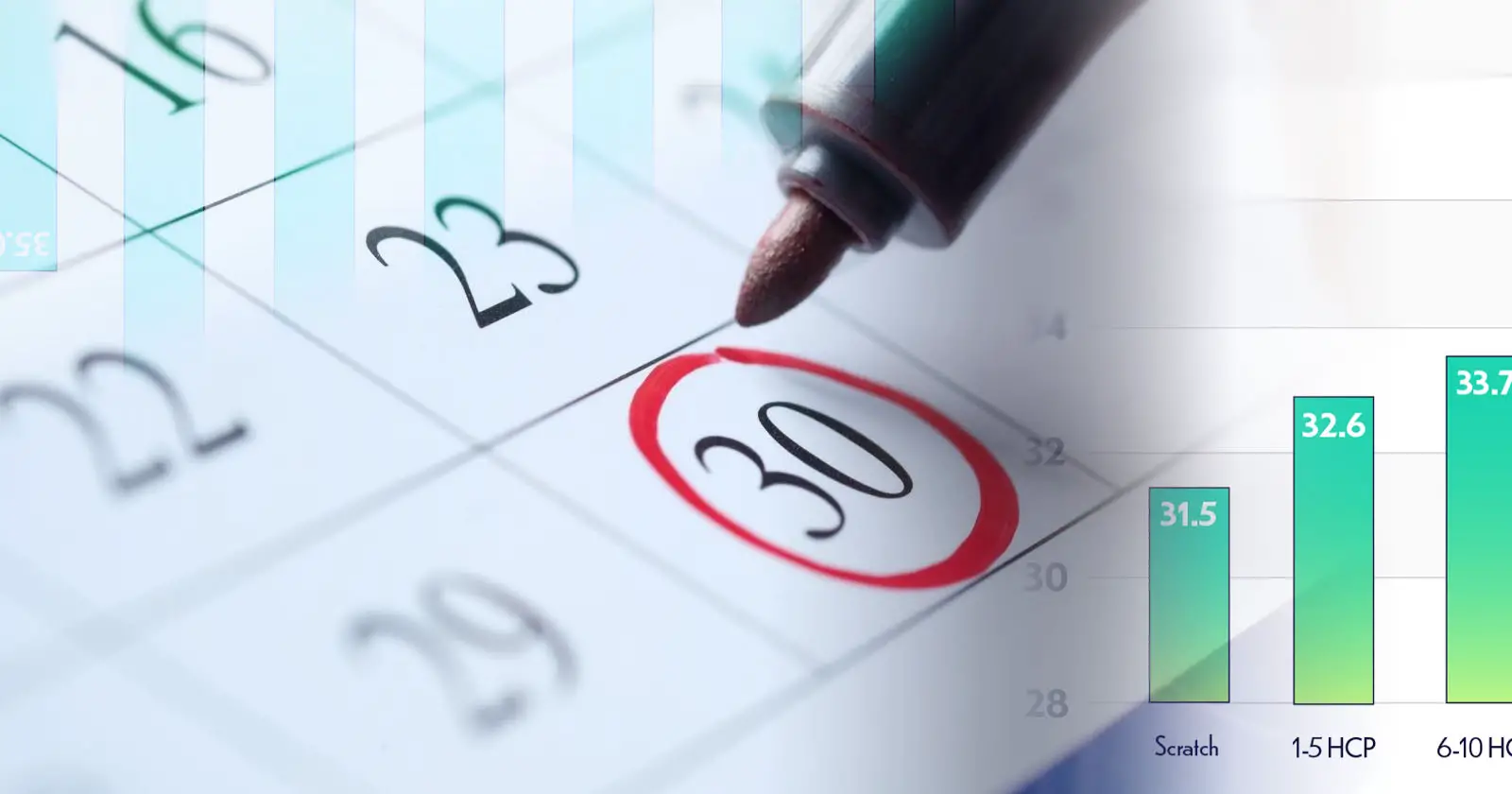
For most amateurs, playing better golf doesn’t necessarily mean dropping 10 strokes off your game in a matter of weeks.
Developing a consistent pre shot routine, a repeatable golf swing, making the right decisions around the greens, and refining your putting stroke, then I guarantee your golf game will be better in 30 days.
As with most things in life, getting better at golf requires a handful of principles to elevate your golf game and propel you to shooting better scores.
Wether you’re a 20 handicap looking to become a 10, or a 5 handicap looking to become a scratch golfer; every single one of us are simply looking to play better golf when we step foot on any golf course.
Now, if you’re thinking to yourself that becoming better at golf in 30 days sounds a bit unreasonable, then your expectations may need to be adjusted a little bit.
It’s all about knowing where you are in your game today and realistically knowing where you want to be in 30 days.
Let’s get to it…
How to get better at golf
This requires a formula, which is goals + money + time + practice + competition = getting better at golf.
But to be completely honest that’s pretty much it in that particular order.
To actually see if you are getting better at golf requires GOALS, and those need to be measured to track your progress.
After that it’s time to start allocating your time and resources to start working towards those goals.
Along the way you need to start playing with better golfers too so you see how they navigate the golf course.
Swing the right golf clubs
Now, this step isn’t necessarily for the lower handicappers looking to break 70 in the next 30 days. More than likely golfers with low handicaps have already done the due diligence in getting fitted for the perfect golf clubs to fit his/her swing.
This step is more for the medium-to-high handicappers that haven’t begun the magical journey of finding the best golf clubs for them.
I realize that time is a factor when we’re talking 30 days to improving your golf game, so that really negates the process of getting fitted for golf clubs and waiting a number of weeks for them to actually be delivered.
You really need to be aware of your swing speed most importantly. If you have a higher swing speed you’re never going to shoot lower scores with regular flex shafts.
You at least need to be swinging stiff-to-X-shafts to account for the club to minimize how much it will flex on the downswing.
Golfer average club head speed
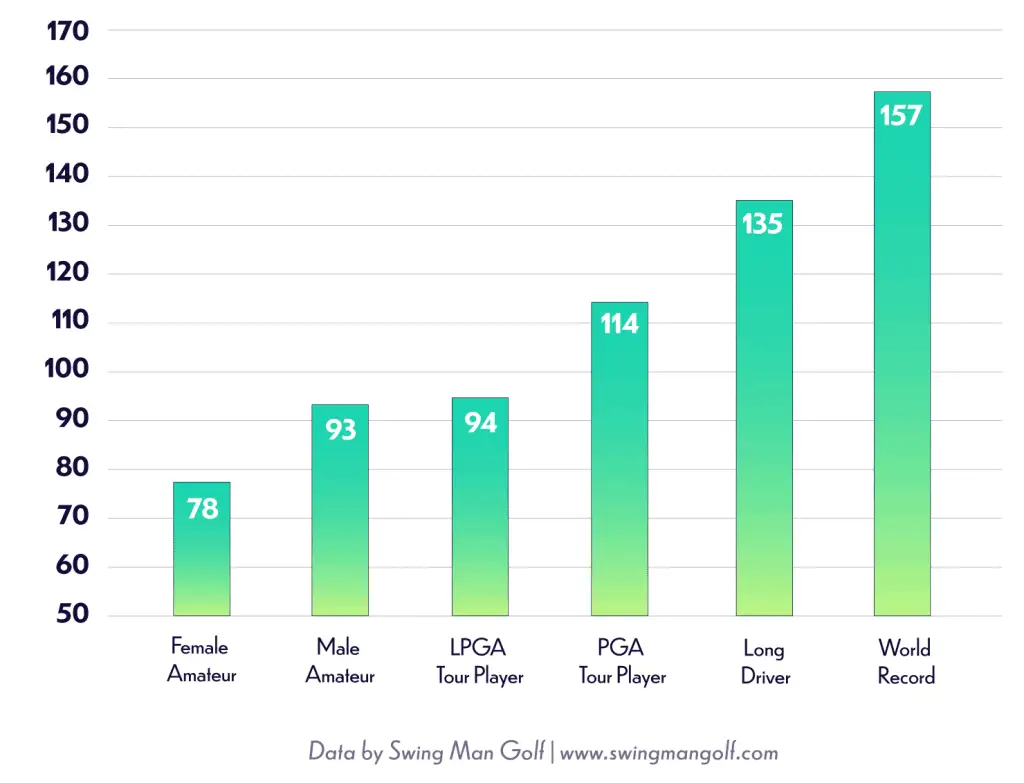
Pick the best golf ball
This will be a little easier to digest than picking the right golf clubs. No matter what category of golfer each of us fall under, we’re all looking to hit a golf ball that a) maximizes distance off the tee, and b) provides exceptional feel around the greens.
So, go grab all the remaining Top Flites in your golf bag and put those in a bucket on the back porch for the backyard practice sessions.
Disclaimer: For most of my life I’ve played a Titleist Pro V1. To be honest, most golfers can’t go wrong with it. It’s been the #1 ball on the PGA Tour for over many years now. However, with the rise of the TaylorMade TP5X I had to give it a shot. Mainly because it doesn’t spin as much, and my golf swing generates a lot of spin.
If you’re not already playing a tour caliber ball then you’re limiting your chances of shooting lower scores. Normally, you’re looking to spend $50-$60 for a dozen balls.
Ok, so far we’ve touched on golf clubs ✅ and golf balls ✅.
Now we move on to arguably the most important step to becoming a better golfer in 30 days…
Practice time
I know what you’re thinking.
Show me the clip of Allen Iverson talking about practice. Not now.
How much practice to get good at golf?
In a perfect world? 2-3 times a day. 🙂
However, today we’re focusing on getting better in 30 days so we need to be working on at least two areas a day.
This doesn’t mean going to the golf course, or driving range, 2-3 times a day. There are plenty of drills you can do in your living room, or in the backyard.
Just taking practice swings without having any training aids at all does a world of good.
Ways to practice golf at home
Hold a sand wedge while you’re watching TV and rework your grip over and over to get a consistent feel for how you want to grip the club when you do make it to the golf course.
Most of us already have a putting green we can roll out on a flat surface to get some good practice strokes in too.
Tip: If you don’t have one already, buy one that has a line that runs down the center of the mat so you can instantly gauge how the ball is rolling off the putter face.
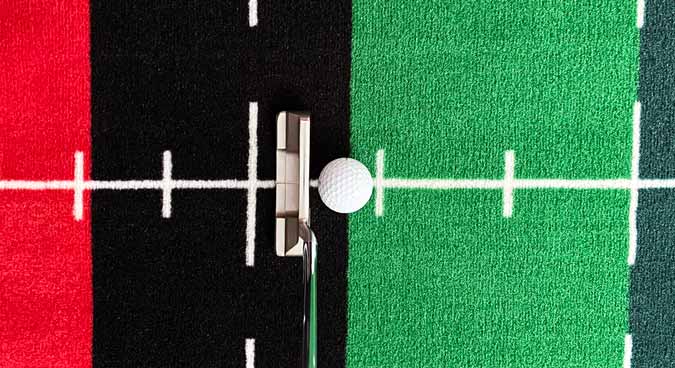
However, my personal favorite way to practice at home is WATCHING golf.
Best golf professional instruction
The best free golf resource we all have is watching pro golfers and how they play golf.
Let Justin Thomas be your golf instructor.
Watch how he sets up to hit each golf shot. Pay attention to the tempo of his swing when he’s hitting approach shots. Try to time your stroke to be the same speed as his.
With that said, you will gain the most value by actually going to the driving range and hitting balls to develop a consistent swing motion.
Every one of us needs to get enough repetitions in with our swing to establish muscle memory.
Taking enough time to practice will be the most pivotal part of you becoming a better golfer in 30 days. Next we’re going to focus on the following:
Develop a pre-shot routine
Golf’s hard. We’re all going to have bad holes, and we’re all going to have good holes. Maintaining a good pre shot routine is way easier to do after one or two good holes in a row.
However, when things aren’t going as well it’s also way easier to forget to do this after hitting a bad shot and just rush up to the ball and hit it again.
By implementing your own pre shot routine you’re allowing yourself to reset each time before hitting the next shot. We all need that fallback to help us focus on executing the best golf swing we can perform before every shot.
You’ll never see pro golfers take a full swing for their pre shot routine. That’s just going to tire you out before taking the shot.
Keep it simple. Start by standing behind the ball (before address) and visualize the shot you are wanting to hit. Take a deep breath and approach the golf ball.
Best way to grip a golf club
The two main ways to grip a golf club are:
Interlock—this is when you interlock the index finger of your top hand with the pinky of your bottom hand.
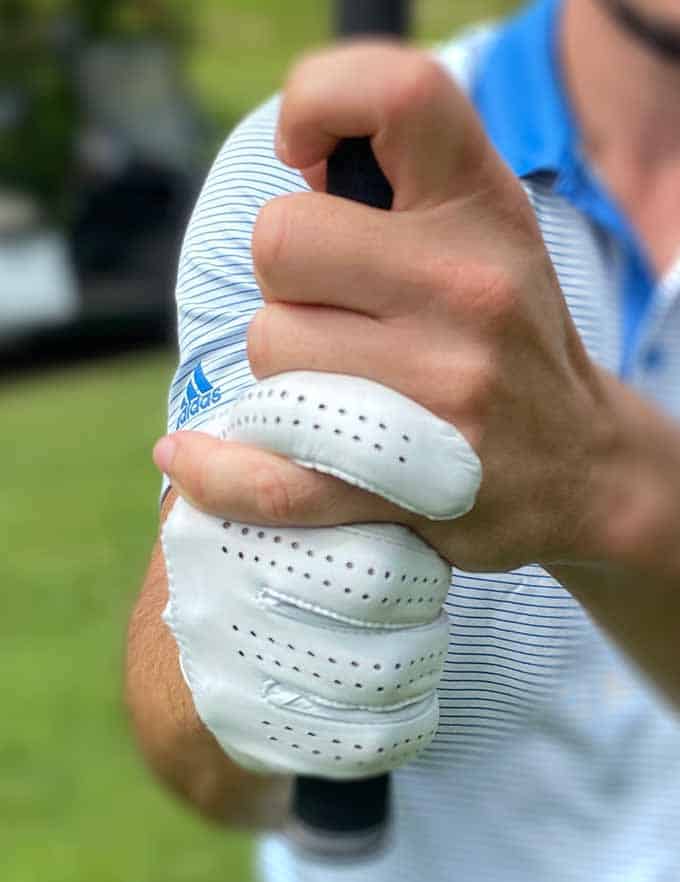
Overlap—this is when you overlap that same index finger of the top on TOP of the pinky in the bottom hand.
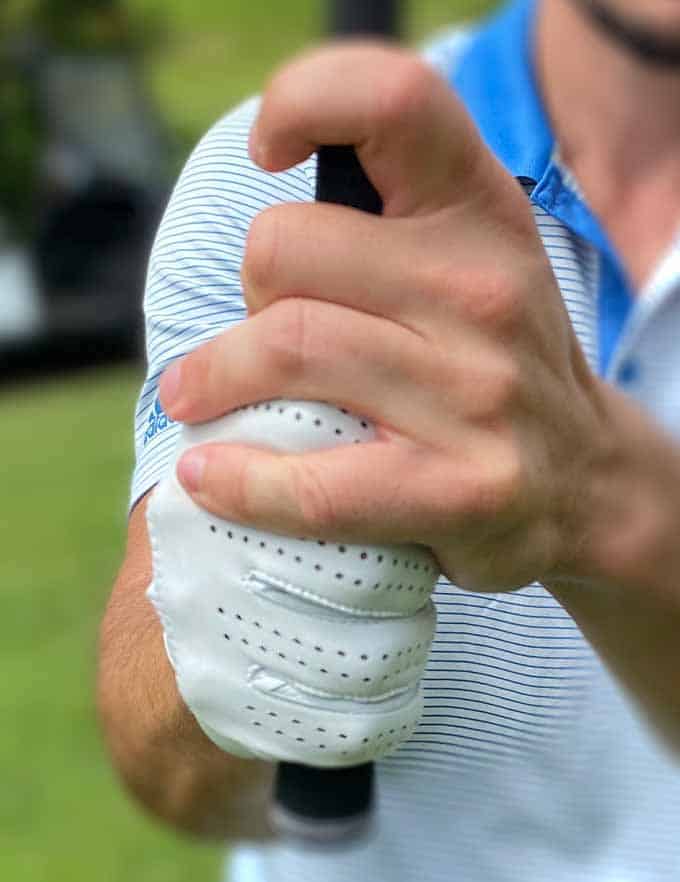
Unless you’re already having success with the overlap grip, try interlock grip since it is the most common among many golfers.
A great way to get your top hand in a comfortable position is to let your arm hang down by your side, and simply let the club rest in the palm of your hand and grip it very lightly.
Tip: If you have trouble slicing the ball too much try rotating your top hand inward to where you can see more of the knuckles. Holding the club with a neutral grip you can typically see the knuckles of your index and middle fingers, so by being able to see the knuckle of your ring finger too would indicate you now have a stronger grip.
For your bottom hand, let it rest on the top hand to where you can’t see the thumb of your top hand anymore.
Now, let’s move on to addressing the golf ball…
How to setup to the golf ball
There is a lot of ambiguity when it comes to where you position the golf ball in your stance. Simply because not every golfer releases the club at the same point.
Here is a good reference point for the most common ball positions:
- Driver/3-wood – ball aligns with the inside heel of the front foot
- Long irons(2-6) – in between middle and heel of the front foot
- Mid-to-short irons (7-PW) – middle of the stance
- Wedges – 1-2 inches behind center
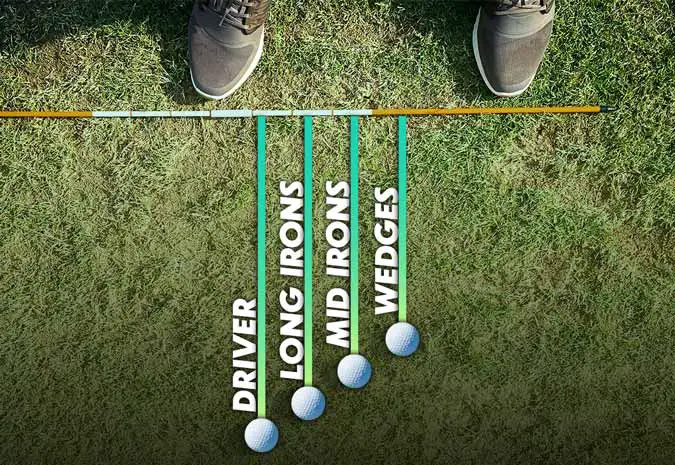
So, play around on the driving range with your ball positions, and if you find yourself not making solid contact with the longer shafted clubs then go ahead and move the golf ball slightly closer to the middle of your stance.
Golf aim and alignment tips
Having a great setup to the golf ball goes hand-in-hand with your alignment. If you’re right-handed and play a fade—unintentionally lining up to the right side of the green will cost you valuable strokes.
Here’s where using alignment sticks can be your best friend. A simple drill to do is place one alignment stick a few inches in front of the ball pointing to your target, and place the other stick along your toe line.
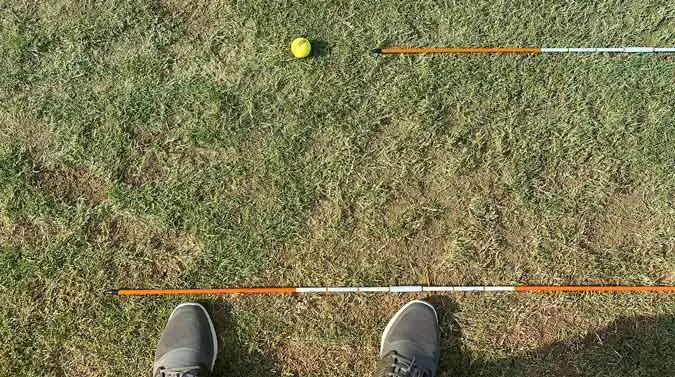
This will help you visualize exactly where the ball should start right after contact. Try and hit a few shots first without the sticks to see where the ball is going, and then place the sticks down to that same target to get a feel for how close you were before and after.
Before we move on to swinging the club, I created a quick formula for awesome ball striking…
Solid ball striking + great distance control = great golf shot 🤓🤯🤓
How to swing a golf club
The short answer here is probably “about 1,000 different ways”, but we’re going to focus step-by-step on the easiest way to swing a golf club.
The takeaway
We are going to focus on 4 things:
Keep your weight centered—It’s much easier to maintain good balance in your golf swing when you adjust the weight to the insides of your feet. The more “centered” you feel in your feet the better you will keep all the moving parts together throughout your swing.
Keep your head still—If you move your head back on your takeaway, your balance is screwed. Keep your head still and focus more on shoulder rotation.
Keep your lead arm straight—the best way to keep the golf club on plane throughout the swing is to try and keep your lead arm as straight as possible. If you let your elbow/wrist break upon the takeaway it will be very hard to consistently strike the ball well.
Load the weight on your back leg—As with any type of swing, the power is generated from the lower body. This especially goes for the longer shafted clubs, but even for wedge shots when we’re not looking for optimal power from your lower body we still need the downswing to be triggered by the legs and hips so the path of the club can follow suit.
The downswing
Here we are going to focus on 2 things:
- Hip rotation and swinging down the plane
- Finishing on your front foot and the subsequent follow through
Start with your lower body—a lot can go wrong in your golf swing when your arms get out in front of your lower body. Most of the time that means a real nasty duck hook. It is much easier to keep the club on plane, and hit through the ball, if we lead with our lower body and hips.
The arms are just along for the ride. We don’t want to be manipulating the golf club with our wrists because we are focusing on rotating the shoulders back around your body.
“Chase after the ball”—I used to have plenty of bad habits on the golf course, and one of the worst habits in my swing was finishing my shots with the weight all on my back foot. The thing that finally clicked for me to actually hit through the shot and finish on my front foot was my Dad(scratch golfer) told me to imagine the club head chasing after the ball.
By imagining that it allowed me to properly shift my weight from back-too-front so that the head of the club was striking the ball along the path of my swing.
You still with me? Awesome 🙂
Let’s transition over to what most golfers deem the most important part of your game when it comes to shooting low scores… the short game.
Best short game drills
Ideally, we would all hit 18 greens and have zero three putts.
Scrambling is a crucial part of anyone’s short game that can turn a 20 handicap to a 10, or a 10 handicap to a scratch golfer.
I always like to take a few minutes to hit 20-30 chip shots before any practice session. This is a great way to simply get a feel for the club in your hands, and establish a little bit of rhythm, before heading to the driving range.
Now, let’s focus on a few short game tips and how you can use a few simple tactics to take with you to the golf course.
How to practice your short game shot
Before you hit any chip shots, hold the club with your bottom hand ONLY and simply swing the club back and forth to get a feel for the club moving along the normal path from which you normally chip the golf ball.
The most important thing to remember when you’re chipping is to try and keep your hands out in front the club head. We want the club head to just follow along with our shoulders instead of releasing the club head (or flicking it) and hitting it fat.
Unless you’re trying to hit a flop shot, always practice keeping a narrow stance with your toes pointing a little forward.
This will help to keep your hips slightly open and all the focus will be on keeping your hands angled out in front of the club head with the emphasis being on hitting the ball with your shoulders.
For ball position, it’s best practice to have the ball sitting between the middle-to-back of your stance.
Tip: One of the more common wedges to chip with is a 56 degree sand wedge. If you have a 60 degree wedge, use that for adding some more loft to your chips and pitches.
A chipping net is a great training aid for helping your short game. Keep one in the backyard for those at-home training sessions to increase your muscle memory and tempo.
Ok, so quick wrap up on what we’ve covered. Golf clubs ✅ , golf balls ✅, practice time ✅, pre shot routine ✅, grip ✅, setup ✅, alignment ✅, golf swing ✅, short game ✅.
Now we move on to the money club… the putter.
How to improve putting stroke
Striking solid putts over and over again will be very important to making more putts.
To do so, we are going to focus on 4 things:
Best ball position for hitting putts
You really don’t want to get too crazy with ball positioning here.
The standard method is an inch or so forward from the center of your stance so you can strike the putt on the way up for better top spin.

What is the best way to grip a putter?
I’ll start by saying this… if you’re already consistently making your putts inside of say 5-6 feet then 100% DO NOT change how you grip the putter.
Now, if those mid-range putts aren’t falling in and you are three putting more than once a round, here are three ways you can experiment gripping the putter for better consistency.
Conventional—This being the most common way to grip a putter. You are simply stacking your hands the same way you would normally hold a golf club, but when putting you want to extend the index finger of your top hand on down to where it’s covering the knuckles of your pinky/ring/middle fingers of the bottom hand.
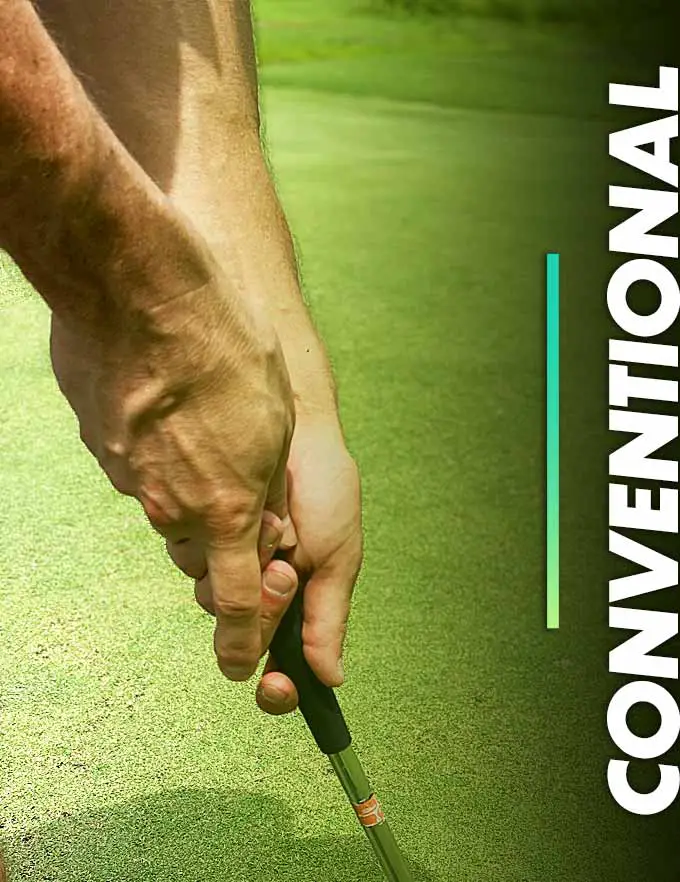
Crosshanded—sometimes more commonly known as “left hand low”, well….unless you are left-handed like me. Many pro golfers put crosshand. The most famous being Jordan Speith. The reason golfers switch to putting left hand low is to try and take the wrists out of the putting stroke, and incorporate the shoulders more into the stroke.

The claw—lets be honest this one just sounds way cooler than the other two. It’s becoming more and more popular among tour pros as well. The most famous one being Collin Morikawa. The goal with the claw is to keep your left wrist more stable and in line with the putter shaft. You will hear some golf coaches describe this as “keeping your wrists quiet.”
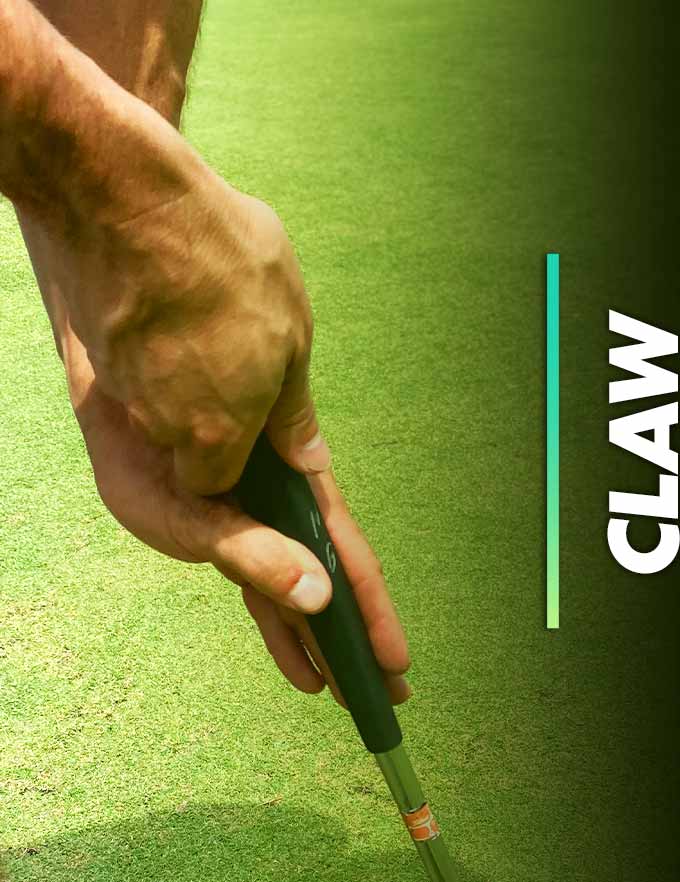
I’ll go a bit more in depth on another day, because there’s just so much to cover when it comes to the putting stroke.
Spend about 10-15 minutes on the putting green and try out these putting methods and see which one feels the best.
To take the experiment a bit further, the next time you hit the golf course try putting with the conventional grip on the first six holes. Then holes 7-12 putt crosshanded. For the final six holes putt with the claw.
Best putter alignment
The best putting stroke in the world can’t overcome bad putter alignment.
So let’s start with a quick drill on the putting green by setting up to a putt how you normally would and drop an alignment stick along your toe line to see exactly where your feet are aligned.
Some golfers like to putt perfectly square while others prefer to keep an open stance to focus aligning the shoulders more to the target.
It’s really going to come down to feel. If you find the ball is consistently starting off line after contact then try the alternative approach.
Best putting stroke technique
There are mainly two ways most golfers putt the golf ball.
- The arc putting stroke
- The straight-through putting stroke
The arc stroke can easily be described as imagining how a door closes. When a door closes it simply swings along a curved arc.
By implementing this style of putting stroke you are preventing the dreaded “block” or “push.”
Switching over to the straight-through putting stroke. It is exactly how it sounds.
Try and keep the putter head as square as you can fro the takeaway to the follow through.
Tip: An easy drill to use for either stroke is to do what Tiger does. When you set you putter down to address the ball, go ahead and stick a tee about .25″ just outside the toe of the putter, and place the other .25″ outside the heel.
Alrighty let’s wrap this puppy up so we can get out to the golf course and start shooting lower scores.
Time to go play golf
Remember the goal, as of today, is becoming a better golfer in 30 days.
Is there a lot to think about after reading this long article (thank you by the way🙂)?
Sure.
But we’re identifying our weaker areas all while starting a new regimen on our journey to lower scores.
Follow us on Twitter at https://twitter.com/wolfitgolf and let me know if you’ve implemented any of these techniques to becoming a better golfer.
